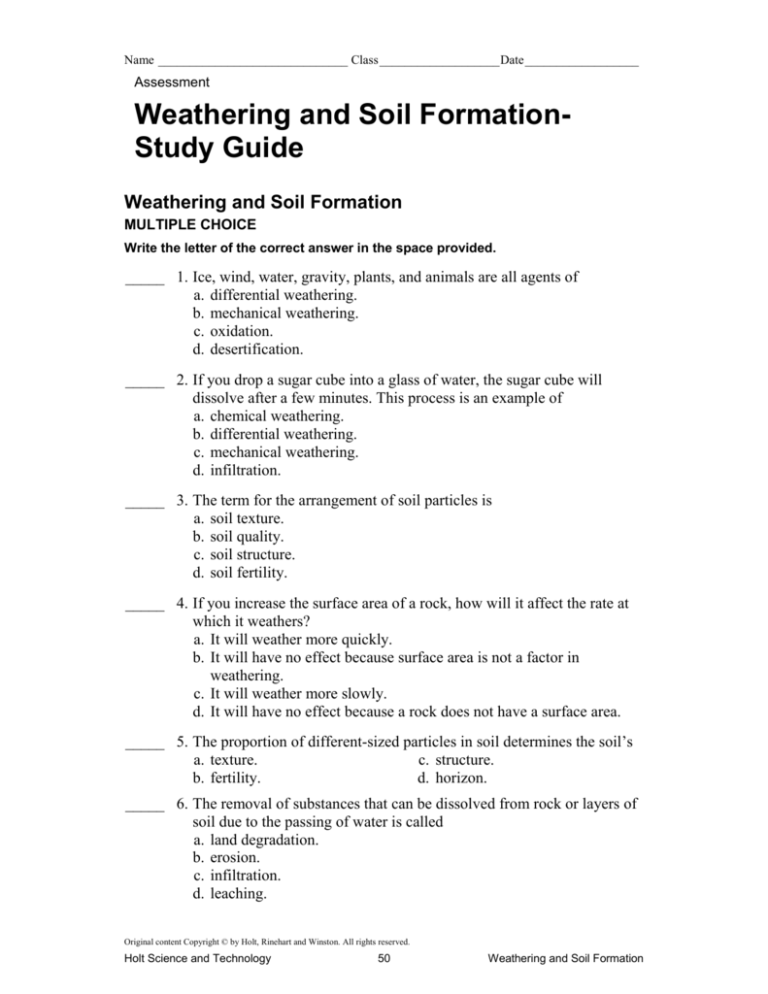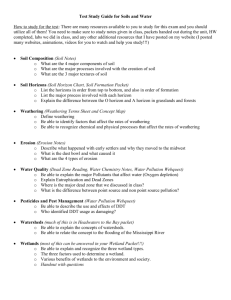
Name ______________________________ Class ___________________ Date __________________
Assessment
Weathering and Soil FormationStudy Guide
Weathering and Soil Formation
MULTIPLE CHOICE
Write the letter of the correct answer in the space provided.
_____ 1. Ice, wind, water, gravity, plants, and animals are all agents of
a. differential weathering.
b. mechanical weathering.
c. oxidation.
d. desertification.
_____ 2. If you drop a sugar cube into a glass of water, the sugar cube will
dissolve after a few minutes. This process is an example of
a. chemical weathering.
b. differential weathering.
c. mechanical weathering.
d. infiltration.
_____ 3. The term for the arrangement of soil particles is
a. soil texture.
b. soil quality.
c. soil structure.
d. soil fertility.
_____ 4. If you increase the surface area of a rock, how will it affect the rate at
which it weathers?
a. It will weather more quickly.
b. It will have no effect because surface area is not a factor in
weathering.
c. It will weather more slowly.
d. It will have no effect because a rock does not have a surface area.
_____ 5. The proportion of different-sized particles in soil determines the soil’s
a. texture.
c. structure.
b. fertility.
d. horizon.
_____ 6. The removal of substances that can be dissolved from rock or layers of
soil due to the passing of water is called
a. land degradation.
b. erosion.
c. infiltration.
d. leaching.
Original content Copyright © by Holt, Rinehart and Winston. All rights reserved.
Holt Science and Technology
50
Weathering and Soil Formation
Name ______________________________ Class ___________________ Date __________________
Chapter Test A continued
_____ 7. What is it called when wind blows sand and silt against exposed rock,
eventually wearing away the rock’s surface?
a. erosion
b. abrasion
c. chemical weathering
d. oxidation
_____ 8. When oxygen in the air reacts with iron, the result is
a. abrasion.
b. differential weathering.
c. oxidation.
d. infiltration.
_____ 9. Mechanical weathering occurs at a greater rate in climates that are
a. cold and wet.
b. warm and wet.
c. hot and dry.
d. cold and dry.
_____ 10. Which of the following is NOT a benefit provided by soil?
a. provides minerals and nutrients for plants
b. allows for water storage for plants
c. provides a habitat for animals
d. can be blown or washed away from its parent rock
_____ 11. Which soil conservation technique prevents erosion on steep hills by
heavy rains?
a. contour plowing
b. terracing
c. no-till farming
d. cover crop
_____ 12. Which soil conservation technique prevents erosion by providing cover
that reduces water runoff?
a. contour plowing
c. no-till farming
b. terracing
d. cover crop
_____ 13. Which soil conservation technique helps restore nutrients to the soil?
a. contour plowing
b. terracing
c. no-till farming
d. cover crop
_____ 14. Which soil conservation technique helps prevent erosion of sloping
hills by heavy rains?
a. contour plowing
c. no-till farming
b. terracing
d. cover crop
Original content Copyright © by Holt, Rinehart and Winston. All rights reserved.
Holt Science and Technology
51
Weathering and Soil Formation
Name ______________________________ Class ___________________ Date __________________
Chapter Test A continued
MATCHING
Match the correct description with the correct term. Write the letter in the space
provided.
_____ 15. rain, sleet, or snow that contains a high
concentration of acids
_____ 16. the process by which softer, less weatherresistant rocks wear away and leave harder,
more weather-resistant rocks behind
_____ 17. the dark, organic material formed in soil
from the decayed remains of plants and
animals
a. differential
weathering
b. bedrock
c. soil conservation
d. humus
e. erosion
f. acid precipitation
_____ 18. the layer of rock beneath soil
_____ 19. a method to maintain the fertility of the soil
by protecting the soil from erosion and
nutrient loss WSFs4
_____ 20. the process by which wind, water, or
gravity transports soil and sediment from
one location to another
Match the correct description with the correct term.
Write the letter in the space provided.
______ 21. These areas get some water from under the
ground, but when it evaporates it leaves
behind salts that can kill plants.
_____ 22. Low soil temperatures and little rain cause
soil formation to occur slowly. Because of
the temperature, decomposition of plants and
animals occurs slowly or stops, limiting the
amount of humus in the soil.
a. arctic
b. temperate forest
and grassland
c. desert
d. tropical rain
forest
_____ 23. The heavy rain leaches nutrients from the
topsoil. Crops can be grown year round
because of the warm soil temperature, so
plants are using nutrients from the soil yearround.
_____ 24. Frequent changes in temperature in this
climate lead to frost action, which allows
thick, fertile soil to develop. The soils in this
climate are some of the most productive in
the world.
Original content Copyright © by Holt, Rinehart and Winston. All rights reserved.
Holt Science and Technology
52
Weathering and Soil Formation







